Note: since this newsletter is mostly visual I thought it would be counterproductive to do an audio version. However I did find some great music that I had intended to use in the podcast: "De La Calle" by Bombasta. Puro Westside.
San Antonio, of course, used to be part of Mexico. That was until the immigrant Americans, who had been invited to settle here and help develop what was then hard core frontier land, revolted and broke away and founded their own nation. The battle of the Alamo and all that. But for purposes of this story it’s sufficient to know that from the time the first Europeans arrived in 1691 until the founding of the Lone Star state in 1836, San Antonio was either part of the Spanish Empire or part of the nation of Mexico.

Our roots as a city are deeply embedded in the culture of Mexico and that can be seen in the bilingual street signs, the historic markers and in the pervasive and amazing mural art.
Mexico has a long tradition of mural art, dating all the way back to the ancient Maya, 2,000 years ago and the Olmec before them. Some of that art can still be seen.

The tradition continued after the Spanish conquest. Mural art was used to introduce the indigenous people to the stories and ideas of Catholicism. Even illiterate people can look at pictures and get the meaning.
The Mexican Revolution of 1910, fighting against the tyrannical rule of Porfirio Diaz and the hacienda system, was a political revolution but it was also inspired by and depicted by artists. Jose Clemente Orozco, José Guadalupe Posada and Gerardo Murillo, better known as Dr. Atl came to fame, among others.

A new government was formed after a bloody 10 year civil war and part of the government’s plan to establish a new identity was through the use of mural art. A national movement was fostered and artists like Orozco, David Alfaro Siqueiros and of course Mexico’s most famous muralist, Diego Rivera gained renown. Rivera sought to incorporate Mexico’s illustrious past with the promise of a glorious future.
In the United States, the Mexican muralists served as an inspiration for the Works Progress Administration (WPA) introduced by President Roosevelt, which commissioned 3600 artists to create murals and sculptures for public buildings across the United States. Although their depictions weren’t political, per se, the intention was to make art public and accessible and to remind all that hope remained alive in the midst of the Great Depression, that the dignity of the American people was still intact and would see us through.
Mexican muralism also helped jump start the Chicano movement in the sixties and establish Mexican-American artists who wanted to create their own aesthetics, to celebrate their own cultural heritage, to illustrate their own struggles and their own social issues.
And that brings us to San Antonio, where an underserved but vibrant Westside was thriving along with the art and music of the Chicano movement. Graffiti and street art were also part of the growing community identity.
This mural located at Buena Vista and Colorado depicts Emma Tenayuca, the young woman responsible for the pecan shellers strike in 1938, protesting the unfair and unsafe working conditions for the hundreds of mostly Hispanic women making three dollars a week shelling pecans. They worked in dusty conditions without proper ventilation or lighting, without inside toilets or washbowls. In the end they defeated the business owners, City Hall and the police and won concessions.
It also depicts La Gloria, a neighborhood bar where the locals would drink beer, make art, shoot pool, reminisce and discuss the politics of the day. One of the characters in the upper right corner of the mural is Jose Riojas, aka Tata, the great-grandfather of Katie Best-Richmond of Rose Hip Coffee fame who is also featured in the Dec. 16, 2021 rohn report, Interview with Katie. He was a mover and shaker back in the day.
The gentleman at the lower right is speaking out, “Let Life be a festival, a festival of Happiness and Justice. The New World Where There Will Be No Rich Nor Bombs Or Wars. Where The Only Hunger Will Be For Justice.” he says.
This mural, with its depiction of native people engaged in their daily activities: hunting, fishing, farming, grinding corn and weaving cloth is at the corner of San Jacinto and Guadalupe on the near West Side.
It shares a similar sentiment with the people gathered at La Gloria.
From Westside San Antonio, the mural art migrated downtown and became part of the urban landscape. Now the murals are commissioned by the city (Centro San Antonio) and have become an expression of our civic pride, part of our presentation to the world. This is who we are.

This mural was created as a symbolic emotional response to the murder of George Floyd in 2020. Two women, one indigenous, one black, touch hands in the water and lock eyes in a gaze of support, trust and solidarity. All around them, lotus flowers bloom. “This mural stands as a symbol of solidarity between our people who have been persecuted and abused for centuries but whose strength and perseverance lead their survivors to continue ‘blooming’ each day regardless of the circumstances.” reads the Centro San Antonio website.
The creativity of the artists has not been muted by their downtown locations. Witness this 10 story high mural at Houston and Jefferson. I remember speaking to the artist, Rudy Herrera, as he was standing next to the giant crane that was about to lift him into the sky.
“What does it mean?” I asked.
I forget now what his reply was. That was some time ago. How could you possibly explain this anyway? I do remember that ‘2012’ was his daughter’s birth year so maybe that’s her on the magical moose animal character.

I’m not sure what they were thinking with this mural. Oh, now I know. I’ve had this conversation with myself, more or less.
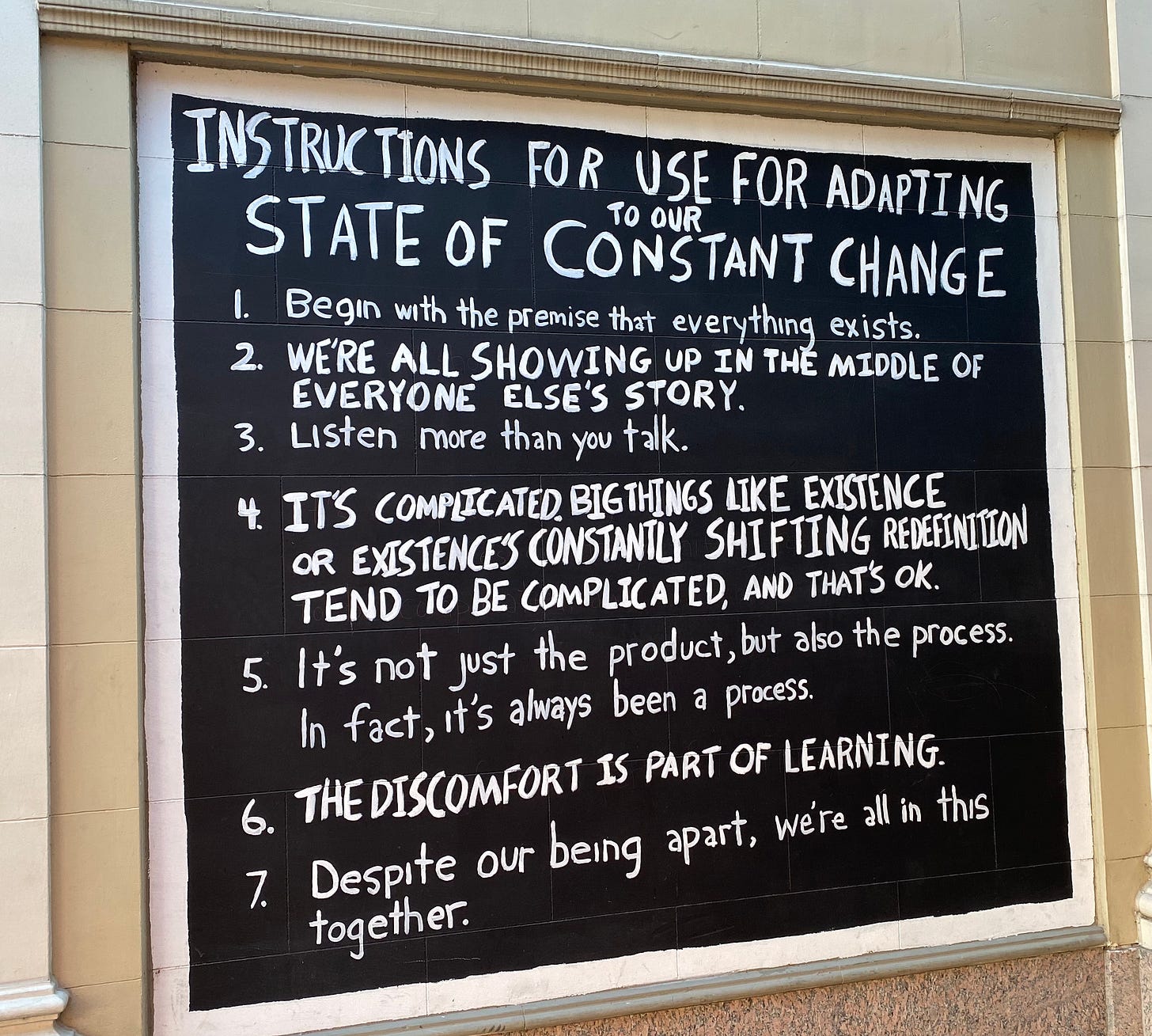
When I saw this it kind of restored my faith in humanity. Simple honest truth can do that.
If you’re anywhere around the Tobin Center, make a point to stop by and see this assemblage of portraits by Lionel Sosa, Living in My Skin at Auditorium Circle and 4th. “Thirty-three Black males, ranging in age from 10 to 90, tell stories they seldom share with people outside their race.”
With quotes by Paul Laurence Dunbar, “We wear the mask that grins and lies. It hides our cheeks and shades our eyes.”
The famous River Walk winds through downtown. Art adorns it’s shores.
Here the artist portrays his father, Horacio Sanchez Valderas, dressed in his 1930’s mariachi outfit on the side of a building overlooking this site. The mariachi tradition celebrates the joys, struggles, and triumphs of the Mexican people. It was the music of country people, the ‘country music’ of Mexico. You will hear this echoing up and down the River Walk, the guitars, the trumpets, the harmonizing voices singing with all their soul.
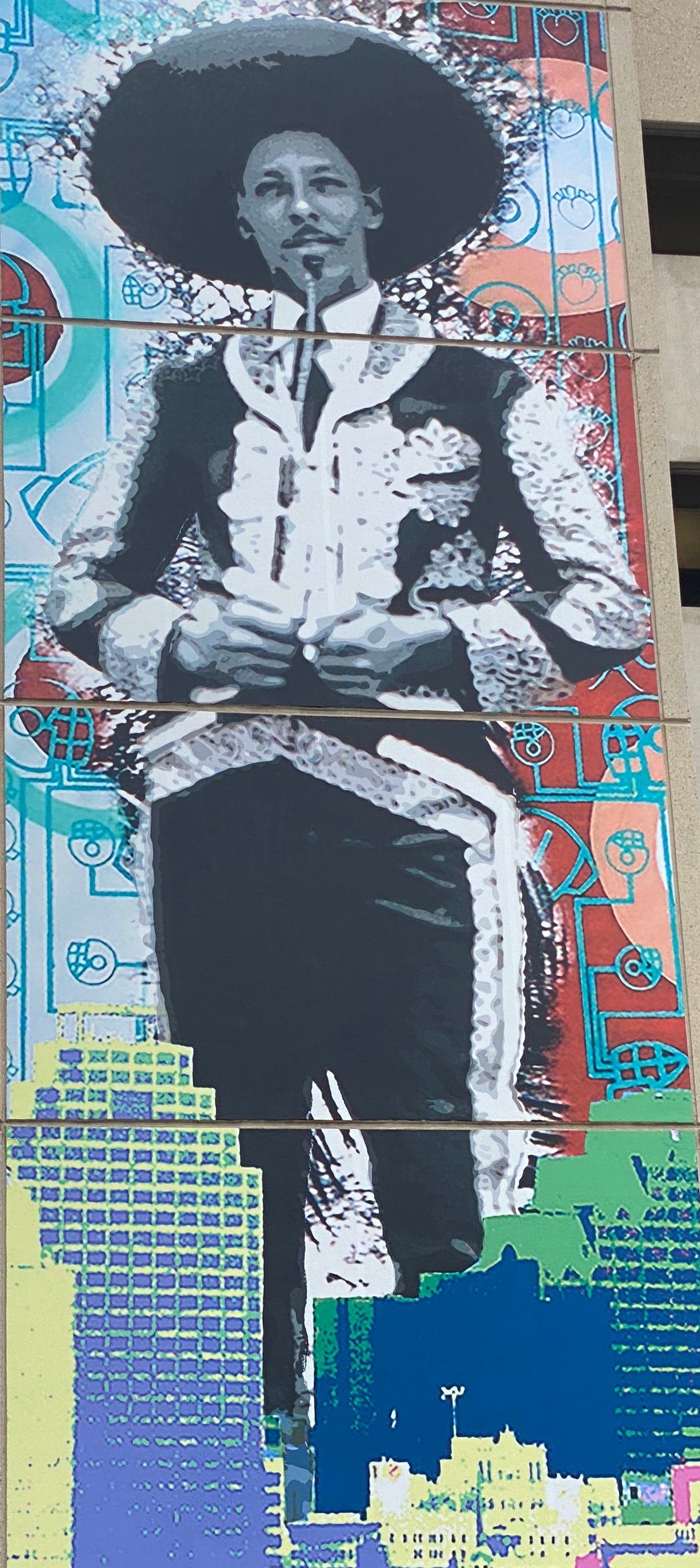
Mural art can be found all over North St. Mary’s as it proceeds out of the downtown and into the club and restaurant district.
Under the I-35 bridge where it crosses St. Mary’s is a gallery of mural art painted on the columns holding up the thundering freeway overhead. Each column holds a unique style and message, from the Corn Goddess to somebody that looks to me like the Hebrew God, from graffiti style images to ‘no more bombs’. Sponsored by the San Antonio Street Art Initiative SASAI. It’s called the SASAI pillars.

“Since 2018, SASAI has completed over 60 murals and has advocated for the careers of over 45 artists. SASAI seeks support to help grow programming in the education department and continue building the “LARGEST OUTDOOR GALLERY IN TEXAS™”, their signature event of advocacy.”

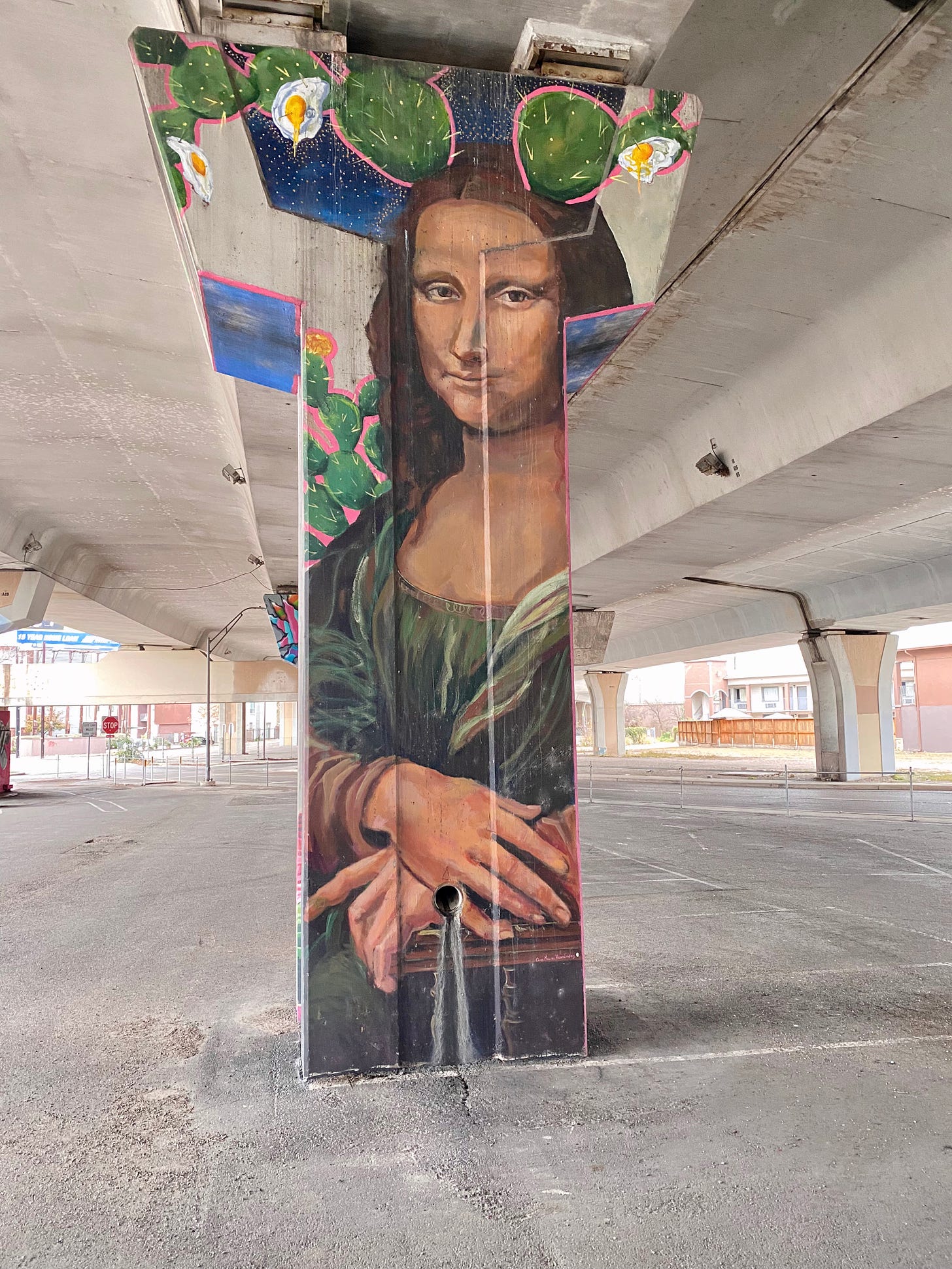



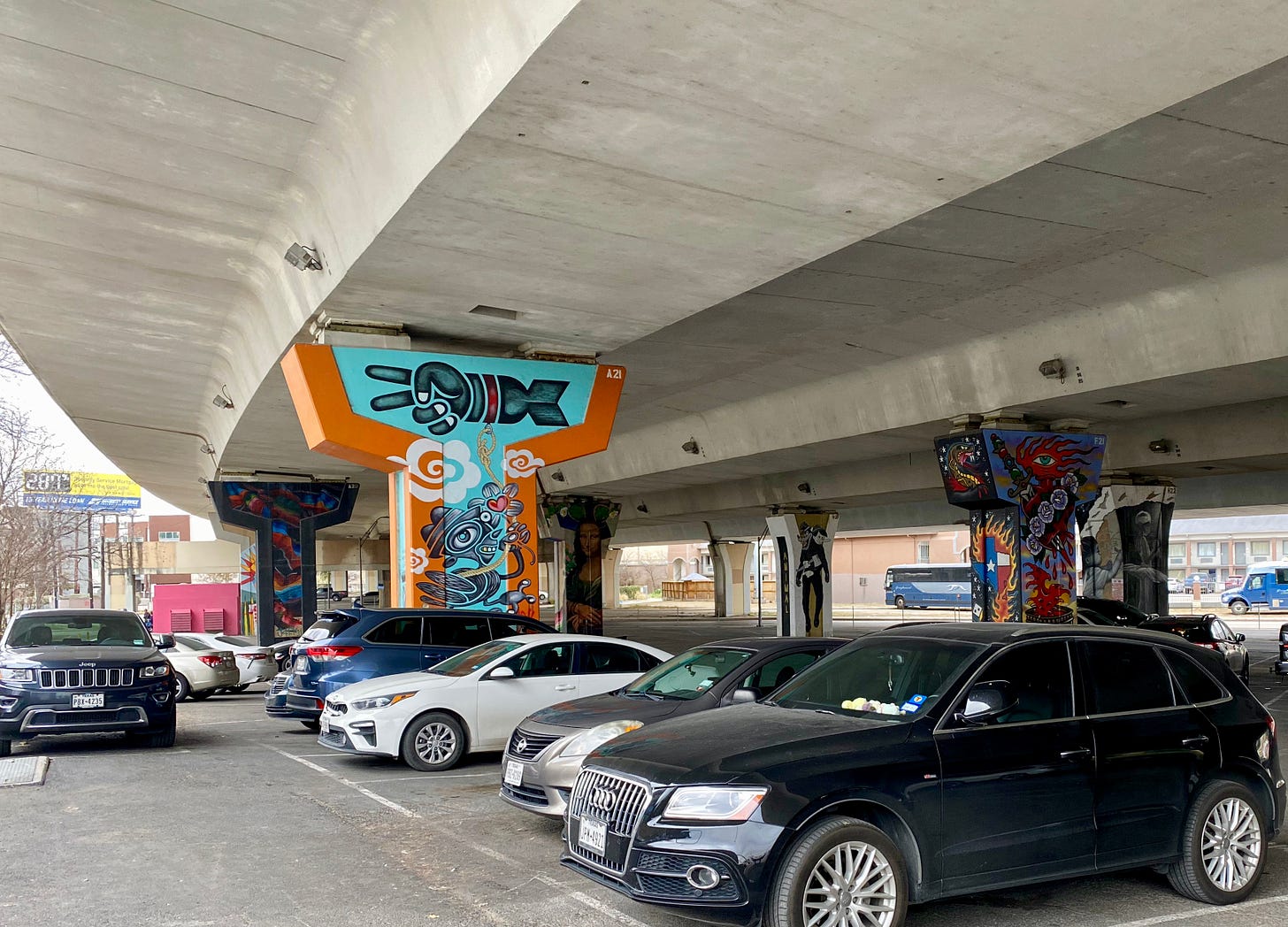
Across from Travis Park and the St. Anthony Hotel downtown is the Travis Park Church, established in 1846. Their motto, if I might presume as much from their literature is, “All are welcome”. They serve the “rich and poor, housed and homeless, gay and straight, black and brown and white, secular and sacred, PhD and GED” and “seek to make the world a better place through transformation of self and community.”
Their ministry extends to the large wall on E. Travis where this 6 panel mural, Love Conquers Hate, was recently installed.


If this image is not familiar to you . . .
then compare it to the mural at the Guadalupe Cultural Center on Guadalupe Street.
Even more ubiquitous than the downtown murals are the downtown homeless people, slumped over or sleeping in the door stoops. Not really part of the art community but a creative expression of their own none the less.
God bless us all and our art. Are we not reaching for the divine in our expressions of beauty? Seems to me. Could be. Might save us all if we could see the beauty in everything.
There is so much more mural art in San Antonio that I didn’t cover. Contact Centro San Antonio, San Antonio Street Art Initiative or your local bike shop for a bike tour. Explore the city and discover what’s out there. (Clue, 1300 Hoefgen Ave) Peace and love.
please let me know what you think of this post
join up and receive regular notifications of the rohn report
share with a friend
make a donation























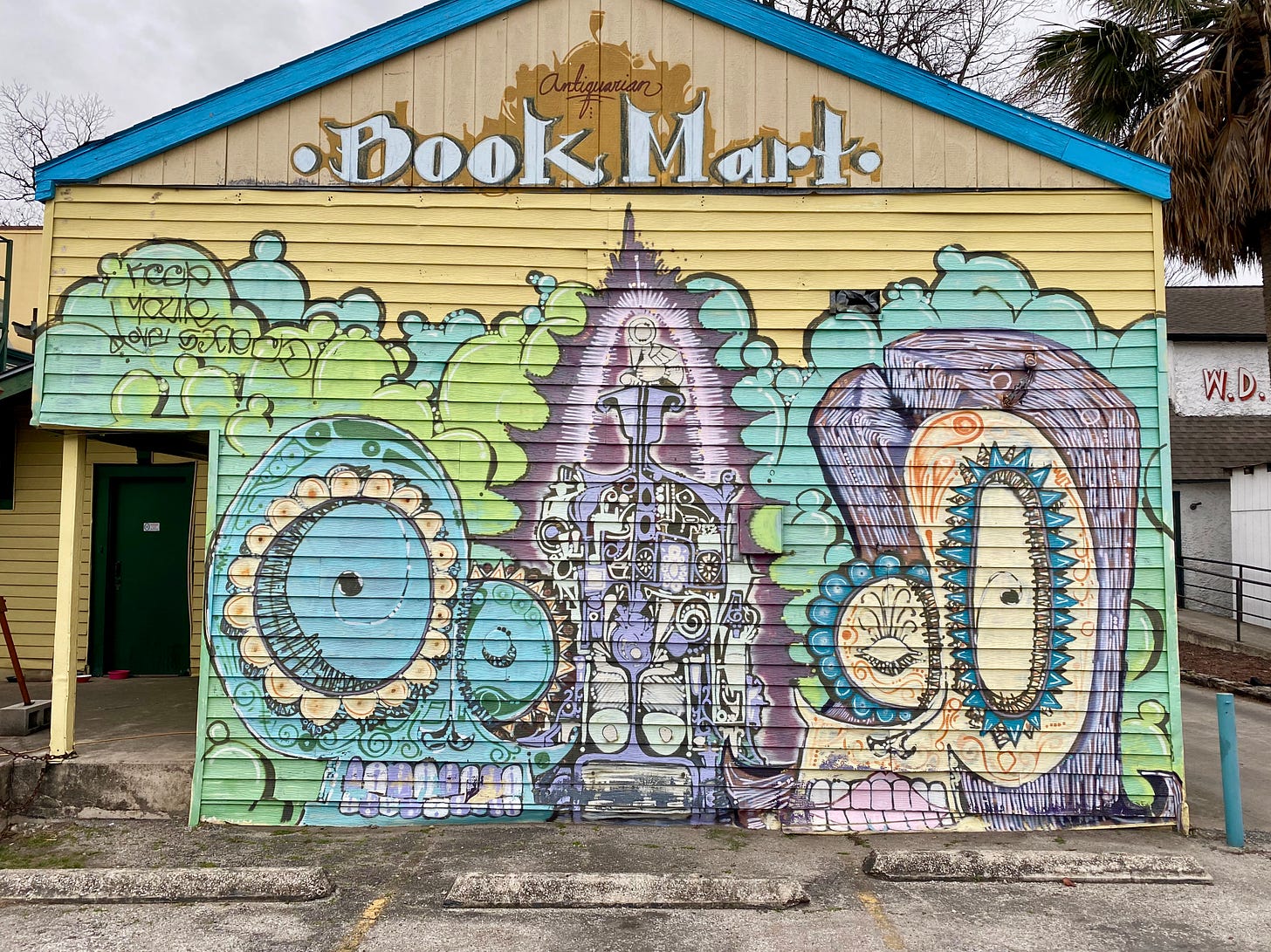


The piece “INSTRUCTIONS FOR USE FOR ADAPTION TO OUR STATE OF CONSTANT CHANGE” speaks to my inner being.
I enjoyed the tour. Thank you!